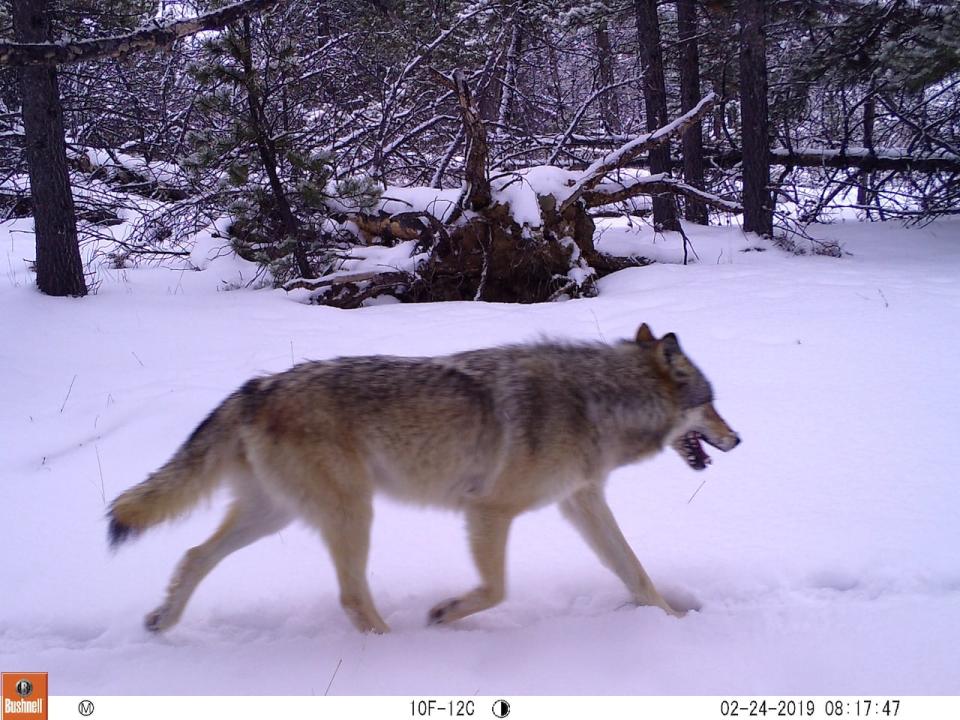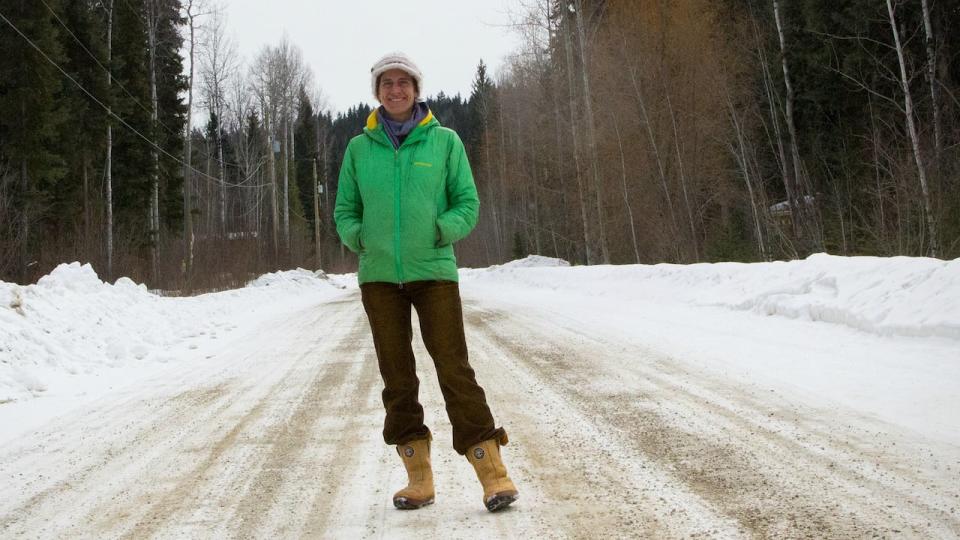 A wolf expert in B.C. is praising a Yellowknife woman for the way she handled an encounter with a pack of wolves near Yellowknife over the weekend.
A wolf expert in B.C. is praising a Yellowknife woman for the way she handled an encounter with a pack of wolves near Yellowknife over the weekend.
Stephanie Yuill told Lawrence Nayally, the host of CBC’s Trails End, she was walking along the shore of Fox Lake on Saturday when she rounded a point and spotted what she initially thought was a group of sled dogs trotting toward her.
“I probably took another five or six steps, because I was thinking it was a dog team, and then they started howling, and then I started freaking out.”
Yuill said the two dogs she was walking — her own dog Eliza and another named Lazlo — bolted away from the pack.
“I had hiking poles and I started banging them together and I’m just like ‘hey, hey, hey.’ I know sometimes dogs respond to deeper voices, so I put my best deep voice on. I started yelling at them.”
Sadie Parr has studied wolves in Canada and the U.S. for 15 years, and said that Yuill did “so many of the right things” during the encounter. One of her many wolf research-related jobs was to build a wolf and person conflict prevention plan for B.C. Parks.
 Sadie Parr lives in Golden, B.C. She doesn’t consider wolves to be a threat to humans, but she’s urging people to leash their dogs for walks, because dogs are an ‘attractant’ for wolves and other large carnivores. (Molly Segal/CBC)
Sadie Parr lives in Golden, B.C. She doesn’t consider wolves to be a threat to humans, but she’s urging people to leash their dogs for walks, because dogs are an ‘attractant’ for wolves and other large carnivores. (Molly Segal/CBC)
“It’s important to try to remain calm in those situations, which can be very, you know, tricky,” she said.
If you encounter a wolf, the territory recommends that you raise your arms to make yourself as big as possible, make loud sounds, and exhibit aggressive behaviour like throwing objects at the animal. If the wolf does not immediately run away, the territory says to continue to make yourself appear large and back away slowly without breaking eye contact with the wolf.
A few moments after the dogs bolted, they came back and Yuill was able to put them on leashes.
“We started walking back. I take about 20 steps and I turned around and they aren’t running but they are following,” said Yuill, who started yelling at the pack and clanging her hiking poles together again.
She’s unsure how long the process of walking a short way, turning around, and yelling at the pack went on. But eventually, when she turned around, she saw most of the wolves were heading back across the lake in the other direction.
“Except for one. One just sat in the middle of the lake, two of them started pacing on the other side of the lake, and six of them just disappeared into the trees.”
The wolves continued to howl, and Yuill said she was terrified the animals were drifting closer to her through the trees. Unsure what else to do, she scaled a hydro tower and reached the Department of Environment and Climate Change (ECC)’s wildlife line by cellphone.
She said Danny Beaulieu, the wildlife officer on the other side of the line, stayed on the phone with her as he made his way to her location, so she didn’t have to leave the area alone with the dogs.
“Danny … you’re still my hero,” she laughed.
Wolf escorting dog off territory not uncommon, says expert
The N.W.T.’s Department of Environment and Climate Change (ECC) posted about the encounter on social media, warning those who use trails at Fred Henne Territorial Park and the area stretching up to Vee Lake to take “extreme caution” because wolves had shown “brazen stalking behaviour” toward dogs.
Parr, however, takes issue with characterizing what the wolves did as stalking.
“I don’t like the word stalking because to me, it implies aggression, and I don’t think that’s fair to presume in this case,” she said. While acknowledging that she wasn’t able to assess the wolves’ body language herself, Parr said what Yuill described is “not atypical” of wolf behaviour.
“The wolves simply made their presence known and then shadowed or escorted those unfamiliar canids off of their territory, trying to make sure that, you know, they weren’t coming closer.”
Parr said wolves are “very sensitive and shy,” and could have been protecting a carcass or a nearby hunting opportunity. They might also perceive dogs as a direct threat to their pups, she said.
“Wolves and most animals really want to avoid conflict, right? It’s a physical risk and it takes a lot of energy, and wolves need as much energy as they can simply to feed their family, to stay warm in the winter.”


A file photo of a wolf in the N.W.T. There are three types of wolves in the N.W.T. Timber wolves, also called boreal wolves, tundra wolves, and Arctic wolves. (Dean Cluff/Government of the Northwest Territories)
There are three types of wolves in the N.W.T.: tundra wolves, Arctic wolves, and timber wolves which are also known as boreal wolves. Lee Mandeville, a wildlife and environment manager for ECC in the North Slave Region, said the pack spotted near Fox Lake over the weekend was likely made up timber wolves. They rely on non-migratory prey like moose and bison, and maintain regular territories.
He also said there is a known wolf den in the area where Yuill had been walking.
“They can get pretty aggressive toward domestic pets, especially dogs, especially leading up to and during breeding season, December to February,” he said.
Parr doesn’t believe wolves pose a threat to humans, but dogs are another story. She said the dogs accompanying Yuill may have been at risk. Wolves mark their territory by howling, urinating and defecating — and dogs don’t always pick up on those signals, she explained.
“I think it’s really important for people to understand that dogs are … an attractant to not only wolves, but other large carnivores as well,” she said. “I would encourage dogs to be leashed at all times.”
Between social media posts and reports to the wildlife line, Mandeville said ECC logs about 20 wolf sightings across the territory per year. The department said numbers this year are consistent with past years.
*****
Credit belongs to : ca.news.yahoo.com
 Atin Ito First Filipino Community Newspaper in Ontario
Atin Ito First Filipino Community Newspaper in Ontario






